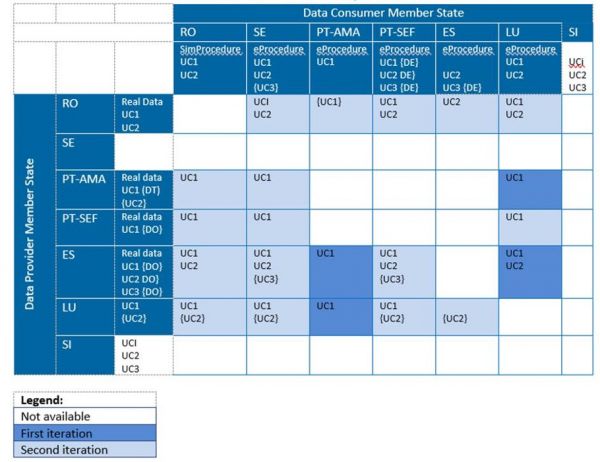Difference between revisions of "MA Use case Definition"
| Line 45: | Line 45: | ||
== Pilot Scenarios == | == Pilot Scenarios == | ||
[[File:Scenarios MA.jpg|left|thumb|600x600px|The follwoing table depicts the different pilot scenarios in each iteration.]] | [[File:Scenarios MA.jpg|left|thumb|600x600px|The follwoing table depicts the different pilot scenarios in each iteration.]] | ||
| + | |||
| + | |||
Revision as of 13:10, 1 June 2021
Partners
Luxembourg
Portugal
Romania
CIO Office: The CIO Office is part of the General Secretariat of the Government (aka the Prime Minister’s Office). It coordinates the IT&C of the Romanian central public administration, establishes the architecture of the IT&C systems, oversees the investments in IT&C and cooperates in the field of cybersecurity with the other law enforcement, defence and intelligence agencies. The CIO Office will coordinate Romania’s participation in the pilot.
Slovenia
Spain
Sweden
Skatteverket (SKV): The main functions of the Swedish tax agency (Skatteverket) are: Taxes, Population registration and Estate inventories. Skatteverket is accountable to the government but operates as an autonomous public authority. This means that the government has no influence over the tax affairs of individuals or businesses.
| Component | National application(s) | Implementation | Description (MS-specific details/constraints) |
| eProcedure Portal frontend | Skatteverket.se/folkbokforing | In development | Estimated in production 2022-01-04 |
| eProcedure Portal backend | Folkbokforing | ||
| Portal to OOP TS interface | Folkbokforing/Skatteverket/SSBTGU | To be developed | Parts of the infrastructure is in place. |
Pilot Scenarios
Use Cases
The description of the MA Use cases in the first pilot iteration includes:
- User Support Intermediation pattern (USI)
- One Evidence Request
- Request Evidence in Procedure
- Preview Evidence in data Service
- Use Evidence in Procedure
- Three evidence types: Change of Address and Civil State Certificate and Birth/Death Certificate
- Interrupted Procedure with support for Save and Resume (optional but recommended)
- Static Look-up of Evidence Type, Data Service, Authorized Authorities
In the Second iteration, the following list is a proposal of functional scope of the Moving Abroad pilots. The actual list of items to be included in the second iteration is yet to be decided by participating Member States.
- Intermediation pattern (UC#3 Pension)
- Improved usability in Procedure and data Service based upon knowledge gained from the first iteration regarding
- Information about the OOP System in Procedure
- Giving consent to use the OOP System in Procedure
- Using the OOP System for Evidence Exchange
- Preview of Evidence in data Service
- Redirection between Procedure and data Service
- Using the exchanged Evidence in the Procedure
- User support and guidance
- Improved fault tolerance and error handling in the OOP System, for example:
- OOP System not available
- Evidence not available
- data Service not available
- Evidence Provider not available
- Delayed response from Evidence Provider
- Evidence not received
- Incorrect Evidence received
- Request multiple Evidences in the same procedure instance
- GDPR Incident and Problem Management in the OOP System
- (Re-)Alignment with SDG
- Handle any critical deviations from the SDG and progress made in other important EU-related projects
- Notification of deregistration conclusion
- Allow for the family contact person to retrieve evidences and submit eProcedure on behalf of all family members.
Interaction Patterns
The development of the DE4A Reference Architecture started in the context of D2.4 Project Start Architecture (PSA) - First iteration and recognizes three distinct Reference Interaction Patterns; out of which MA will use mainly the USI-pattern.
- Intermediation Pattern (MA UC#3 Pensions)
- User-supported Intermediation Pattern (USI)
The USI pattern is a new pattern (developed with in the project) and it will be further developed after learning from the first iteration piloting. The first iteration has architectural shortcomings and does not allow all member states to pilot.
